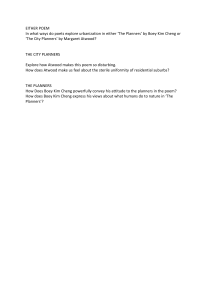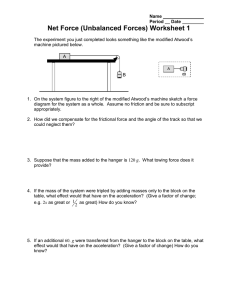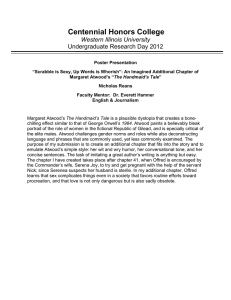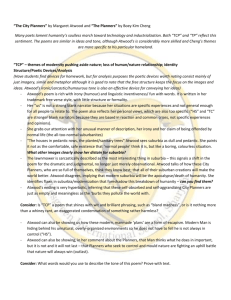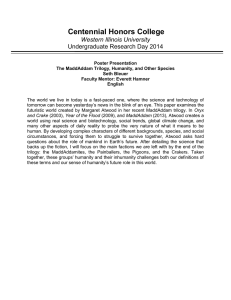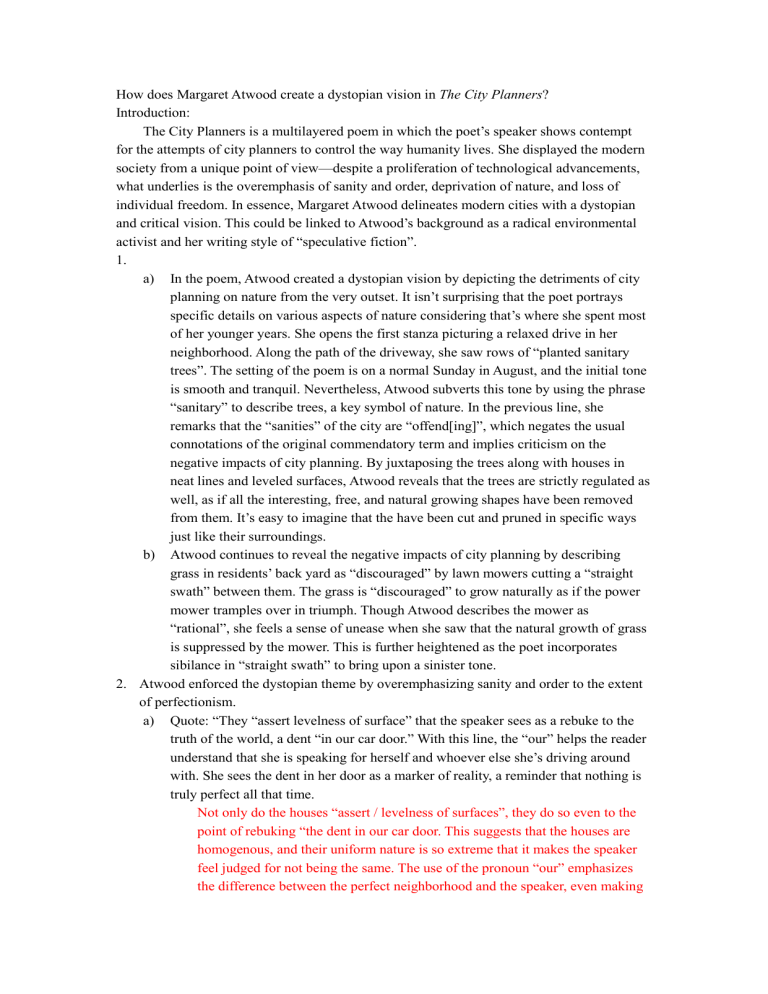
How does Margaret Atwood create a dystopian vision in The City Planners? Introduction: The City Planners is a multilayered poem in which the poet’s speaker shows contempt for the attempts of city planners to control the way humanity lives. She displayed the modern society from a unique point of view—despite a proliferation of technological advancements, what underlies is the overemphasis of sanity and order, deprivation of nature, and loss of individual freedom. In essence, Margaret Atwood delineates modern cities with a dystopian and critical vision. This could be linked to Atwood’s background as a radical environmental activist and her writing style of “speculative fiction”. 1. a) In the poem, Atwood created a dystopian vision by depicting the detriments of city planning on nature from the very outset. It isn’t surprising that the poet portrays specific details on various aspects of nature considering that’s where she spent most of her younger years. She opens the first stanza picturing a relaxed drive in her neighborhood. Along the path of the driveway, she saw rows of “planted sanitary trees”. The setting of the poem is on a normal Sunday in August, and the initial tone is smooth and tranquil. Nevertheless, Atwood subverts this tone by using the phrase “sanitary” to describe trees, a key symbol of nature. In the previous line, she remarks that the “sanities” of the city are “offend[ing]”, which negates the usual connotations of the original commendatory term and implies criticism on the negative impacts of city planning. By juxtaposing the trees along with houses in neat lines and leveled surfaces, Atwood reveals that the trees are strictly regulated as well, as if all the interesting, free, and natural growing shapes have been removed from them. It’s easy to imagine that the have been cut and pruned in specific ways just like their surroundings. b) Atwood continues to reveal the negative impacts of city planning by describing grass in residents’ back yard as “discouraged” by lawn mowers cutting a “straight swath” between them. The grass is “discouraged” to grow naturally as if the power mower tramples over in triumph. Though Atwood describes the mower as “rational”, she feels a sense of unease when she saw that the natural growth of grass is suppressed by the mower. This is further heightened as the poet incorporates sibilance in “straight swath” to bring upon a sinister tone. 2. Atwood enforced the dystopian theme by overemphasizing sanity and order to the extent of perfectionism. a) Quote: “They “assert levelness of surface” that the speaker sees as a rebuke to the truth of the world, a dent “in our car door.” With this line, the “our” helps the reader understand that she is speaking for herself and whoever else she’s driving around with. She sees the dent in her door as a marker of reality, a reminder that nothing is truly perfect all that time. Not only do the houses “assert / levelness of surfaces”, they do so even to the point of rebuking “the dent in our car door. This suggests that the houses are homogenous, and their uniform nature is so extreme that it makes the speaker feel judged for not being the same. The use of the pronoun “our” emphasizes the difference between the perfect neighborhood and the speaker, even making the reader feel included in this imperfect group. Later, she remarks upon the “too-fixed stare of the wide windows”, continuing the personification of the houses, suggesting the street is continuing to scrutinize her. This personification which permeates the whole poem creates an oppressive feeling of being judged by the homogenous, uni b) Quote: “The driveways neatly sidestep hysteria” “No shouting here, or shatter of glass.” c) Quote: “Future cracks in the plaster”, “Houses, capsized, will slide obliquely into the clay seas, gradual as glaciers” The previous stanza ended with an enjambed line, the first line of stanza three picks it up where it left off, describing for the reader how the windows give the speaker a brief insight into what’s going on beneath the surface. It allows her to see “behind or under / the future cracks in the plaster.” She knows that the perfect facade the city planners have created isn’t going to last. Atwood mocks the perfectionist ideals that the and the impermanence of man compared to nature. Flaws in the “perfect world”. 3. Atwood included elements of manipulation and control to create a sense of horror. a) Quote: “Insane faces of political conspirators”, “Transitory lines rigid as wooden borders”. The surveyors are “tracing the panic of suburb order in a bland madness of snows.” The poem concludes with these lines, allowing the reader to determine if anything could come next. It does suggest that this is where the cycle starts again, and a new suburb is created, just as mad and sanitary as those that fell apart, sinking into the earth. The “panic” and “order” of the planning are juxtaposed in this last line, finalizing for the reader their image of what the residential neighborhood is like. b) Quote: “Bland madness of snows”. In the final line, she uses the ungrammatical word “snows.” This could suggest that she’s trying to step outside the bounds of what is ordered and perfect and convey something of a steady decline of structure. It is also possible in these final lines to read the snow and vanishing air as indicators of the climate crisis and how impactful city planning can be on a green economy. How does Boey Kim Cheng explore urban development in The Planners? 1. Cheng presents development as a precise procedure that is highly controlled. a) Context: Cheng returns to his hometown and is astonished by the speed by which the city has developed over the period of massive urbanization. b) The diction of the opening verse is largely positive. Words like “possibilities”, “grace”, “linked” and “desired” suggest everything is working as planned, there are no snarly traffic jams, dead-end alleyways or unsightly, dilapidated areas to spoil the city. c) Quotation: “The buildings are in alignment with the roads which meet at desired points linked by bridges all hang in the grace of mathematics.” 2. Cheng portrays urban development as idealistic and perfectionist. a) Quotation: “Knock of useless blocks with dental dexterity”. Note: “Useless” is a heavy word. Analyze “dental dexterity”. b) The poet starts off the poem describing a meticulously planned city, “The buildings 3. are in alignment with the roads which meet at desired points.” The word “desired” depicts a strong, nearly pedantic force to construct the city by a specific standard. The poet is obviously trying to portray a picture of a vast city so in order that all the roads are aligned perfectly, as if a blueprint in reality. In the second stanza, this idea of perfection is further strengthened with an extended metaphor, “The country wears perfect rows of shining teeth.” By illustrating city planning as a dental operation, Cheng further cemented the idea of planners pursuing an ideal—no flaws are permitted in such surgery. The poet also incorporates various medical terms, namely “Anesthesia, amnesia, hypnosis”. This would be particularly powerful to modern readers who are familiar with those treatments. They share a common context— methods to create an illusion deliberately to make the patient forget. Boey Kim Cheng explores development as a collective ideal that suppresses individual creativity. a) Quotations: “But my heart would not bleed poetry, not a single drop to stain the blueprint of our past’s tomorrow”. Draining the lifeblood of poets. b) Cheng began his bland criticism on development throughout the second and third stanzas. Though city planning seems glorified, it lures individuals into an illusion that eventually blinds them. “Shining teeth” are merely tawdry, and medicine is forced down everyone’s throat so that “it does not hurt”. c) He openly reveals his thoughts, “but my heart would not bleed poetry”. The extremely personal pronoun “my” signifies the outpour of emotions and subverts the reader’s stance on development after immersing in the shimmering delusion. In particular, the phrase “bleed poetry” describes the poet’s works as his lifeblood. Alternatively, “poetry” can be interpreted as a symbol of the author’s creativity. How does Peter Porter criticize life in A Consumer’s Report? 1. Peter Porter criticizes life by revealing its meaninglessness. a) Quotations: “I had it as a gift”. “The world got by for thousand millions years without this, do we need it now?” “Just to keep the maker in its job”. b) “Embarrassing deposit behind” signifies inevitability of death. 2. Porter also presents further drawbacks of the product—difficulties that everyone encounters in life. a) Quotations: “Not economical”, “Shape is awkward”, “Waterproof but not heat resistant”. Bland criticisms on life as it is often unsatisfactory to our needs and desire. By using the word “shape”, it cleverly describes the situation of body shame that people might have. b) “Whenever they make it cheaper they tend to put less in—if you say you don’t want it, then it’s delivered anyway.” Porter is hinting towards economic inequalities within society—you cannot choose the family you are born in. 3. Porter suggests that in we are often swayed or influenced by others in life by using a metaphor related to consumerism. a) Quotation: “Although the instructions are fairly large/there are so many of them/I don’t know which to follow, especially as they seem to contradict each other.”
